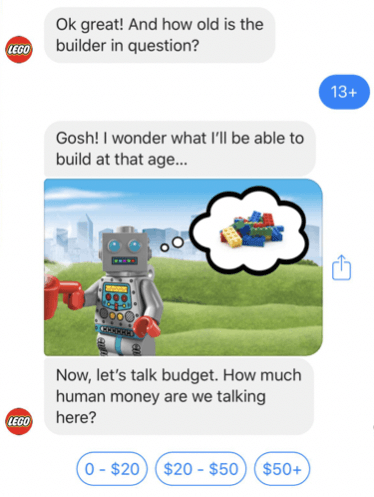Great chatbot copywriting is a crucial component of a successful messenger-based sales campaign. It makes sense to write intriguing sales letters, eye-catching headlines, whatever else.
Now, say you have a decent chatbot but it’s lacking this last bit of “oomph”. Something is not there. How comes your digital representative isn’t pulling their own weight, while chatbots of other companies are chalking up sales big time?
You are right to notice that something’s off here. Even if your chatbot does all the tasks correctly, there’s a chance the copy is simply no good.

Chatbot copywriting in 3 easy steps
There is a reason why it’s a common occurrence. The messengers (and chatbots as a result) are a copywriting playfield that differs from emails or websites. Three big differences set them apart for other communication channels:
- Messengers are more informal (due to being used for friend and family chatting)
- The chat window is constrained in terms of size (due to smartphone screen sizes)
- Chatbots are dominating the mobile market (due to smartphones used for just about everything these days)
This means you are playing on different rules. You don’t have any room for mistake or excessive chit-chat. Your dialogue flow must guide the user without any obstacles. You need impactful, conversational copy that takes them straight to the desired content. To make the experience of using a chatbot smooth and enjoyable, chatbot copywriting is the thing you need to learn.
Without further ado, here comes the little 3-step guide to chatbot copywriting.
Step 1: Connecting with your audience
It’s always baffling to me how something so essential is often overlooked. To communicate well with your customers, you have to speak their language. Here’s what you can do:
Discover your target user persona
This approach is rather simple, yet it gets the job done. What you seek is the user’s intention and what drives to do it. There are three general areas that can help you describe your average user:
- The user (who they are – age, sex, occupation, etc)
- The environment (what makes them seek the help of your chatbot)
- The task (what the user wants to do with your chatbot)
Let’s imagine a pizza delivery chatbot that’s helping a pizzeria near a student dorm.
The user: a college student Mary, aged 20, is employed part-time and lives in the dorm we’re right next to.
The environment: Mary is exhausted all the time. Mary doesn’t want to open her laptop at home after a hard day’s work and college lectures (enough screen time as it is).
The task: Mary eats out or orders pizza instead of cooking stuff. Because of that, she’s often on mobile. A lot of the services she likes to use are on mobile apps, too.
And thus, we have a decent persona we can use to structure the dialogue flows and copy on. In this particular case, we would be adapting our texts to match the style of a college student in the early twenties, with all the memes and social media fad out there.

Mary the Customer Persona’s window
It’s always a good idea to run some split tests and try a couple of chatbots competing with each other, with different copy. If you’d like to run some tests with your teammates in-house, you can also try the Wizard of Oz usability test, which is also highly effective.
Focus on problem-solving
Keep in mind that your users are giving the chatbot a shot because they want something solved. It can be a question, or a request, or simple research. But they probably won’t be spending time with your chatbot just for leisure. Thus, you must prepare your chatbot to anticipate common problems and reflect that both in the dialogue flow and the copy.
Imagine your business is offering computer repairs. You can start the conversation by readily anticipating the most common problems and offering either advice or service to fix them.
Step 2: Maintaining your brand tone of voice
The tone of voice is a mirror into your company’s culture. It breathes with what you are. A lot of businesses forego the discovery of their brand voice, and that stunts their growth. Doug Kessler, the Creative Director of Velocity Partners, said it best in his article on the tone of voice.
Your brand tone of voice should be present in the dialogue flow and chatbot copywriting just as well. You can do these few things to do stand out more:
Give your chatbot a personality
Chatbots often lack a personality and act as simple support bots. It’s not a good idea to fear to express your brand image in your chatbot.
The most common case for a #chatbot personality 🤖 is a complete lack of one. The fear of giving the chatbot a name and a story is sometimes well-placed, but often unwarranted.
Tweet this!
People like to have a human-like conversation, instead of waiting to receive an answer from a soulless machine. It’s great when a chatbot does have a personality and has no problems making clear that it’s a chatbot and not a real person.
A fantastic case of a chatbot copywriting that did it right is Lego’s chatbot: Ralph. Ralph is on Facebook Messenger and was created to help the customers pick a lego kit as a present for Christmas (but later became more than that).
In almost every piece of the dialogue, Ralph shoots casual puns and jokes, keeping the atmosphere cheery. And yet Ralph never forgets of its purpose and helps the user to narrow down their search, driving them to an eventual sale.

Lego’s Ralph the Chatbot in action
With a personality, your chatbot will be easier to remember and more fun to use. Think what kind of personality could fit your brand, and give your little chatbot a heart.
Make a great first impression
The first impression really matters, especially if the first contact with your business is established via your chatbot. Don’t forget that for most people chatbots are still a novelty, something they have never used before. You don’t have the luxury of body language or your voice to support it, only the text and the dialogue flow.
So in order to make a really good impression, create a fantastic intro. Make the first steps of talking to a chatbot as easy as they can possibly be. And make sure to make the chatbot radiate your brand through the texts.
Don’t forget to have some fun
Even if you have a serious(™) business, nothing can stop you from catching the attention with a well-placed joke. Just be sure to time the joke well enough, in order to have maximum impact from it.
It all boils down to being authentic in what you want to say. Same goes to regular copywriting – the information and the offer itself means little to a modern customer. It’s the tone of voice that sets one business apart from all the others. Your chatbot must be the same – it will directly project your branding forward.
Step 3: Using chatbot copywriting
Surprise! I’m not Einstein, but these battle-worn copywriting tips will help you to structure better dialogues for your chatbot. There is nothing difficult here. Clarity and brevity.
Use the KISS principle
Keep it short and simple. This concept applies to most kinds of writing, not limited to conversational chatbots or marketing. Break down complex ideas and sentences into something really simple. Guiding a user in a chatbot interface might be trickier than it seems – and this approach will help.
Get the message across to the user quickly and without beating around the bush. Within the conversation with the chatbot, your user should always know where they are and what you want from them.
Write in an active voice
Passive voice is boring 💤. It has little place in a conversational interface and you will know it when it’s not your case. Active voice has some action ⚡ going on behind it and helps the conversation to remain gripping.
In case you have doubts, here’s what the difference looks like:
🍕 Passive voice: The pizza was brought by me. (meh)
🍕 Active voice: I got us pizza! (yay!)
Again, nothing ground-shattering, but the active voice is really good when used in chatbot dialogues.
Don’t pitch aggressively
It is tempting to try and send your users down the sales funnel quicker but do be patient. There is no need to suggest products or services right away or offer them at every turn. The conversation with your chatbot should be enjoyable.
Pay attention to how information-heavy your dialogue flow is. How many new things are you introducing simultaneously? If the answer is more than 1, you should definitely break the flow up and only offer one thing at the time.
Use filler words sparsely
It’s okay to use filler words like “just”, “like” and the rest of them – to simulate normal human speech. Keep your texts tidy.
Speak in plain words
When you read text written in a messenger by a human, you will notice that it generally is simplified and shortened. Your chatbot should speak the same way. That involves:
- Using contractions. Example: “Don’t” instead of “Do not”.
- Using words like “ah”, “yeah”, “yep” and other common expressions.
- Avoiding too many exclamation points.
And that really is it.
Chatbot copywriting is a whole field of creativity to explore. Keep your dialogues in line with your brand, and your customers will keep coming for more.
Thanks for reading! 😊






